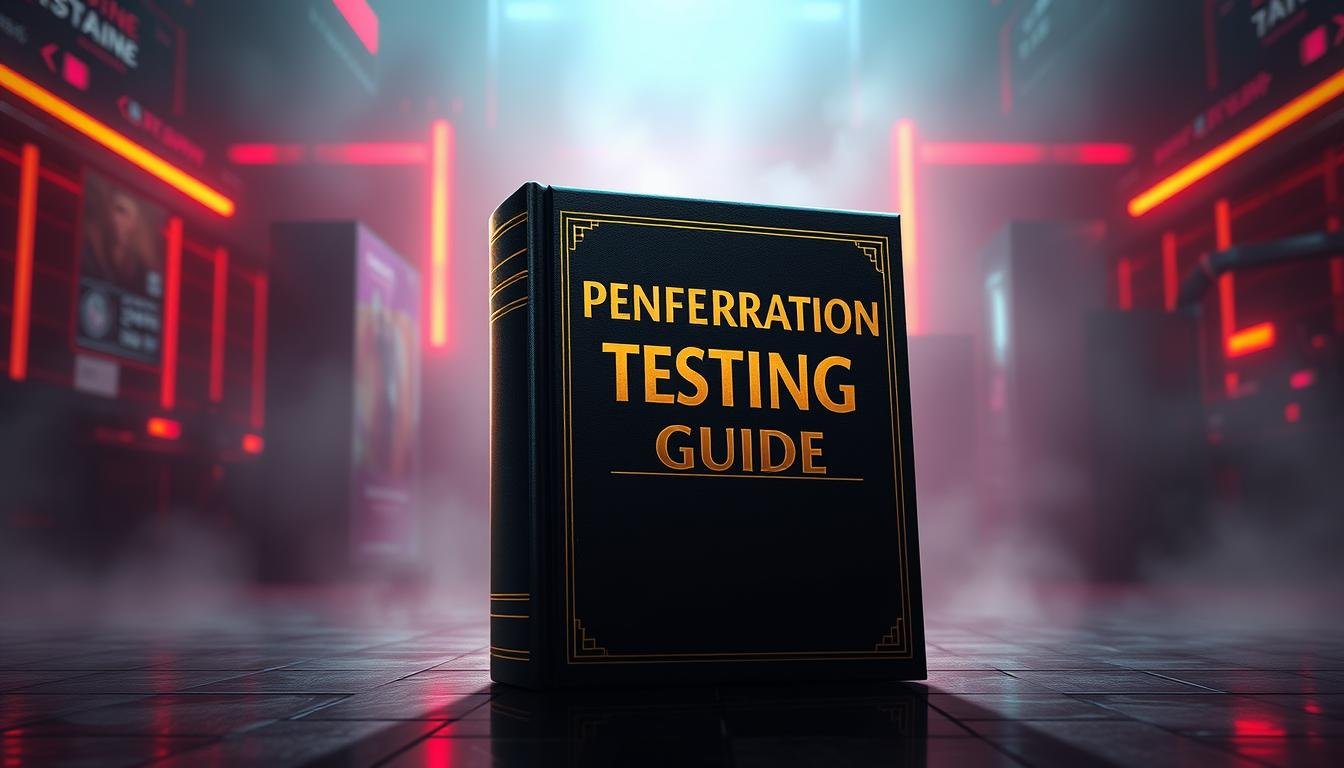Want to defend against cyber threats and find hidden weaknesses? You can protect your digital assets with a detailed plan. This plan shows you where security risks might be.
In today’s fast-changing digital world, penetration testing is key to keeping your data safe. Companies face big risks. Data breaches can cost a lot in fines and lost trust.
This guide will teach you the basics of ethical hacking. You’ll learn how to find and fix vulnerabilities. This helps keep your organization safe from cyber threats.
Key Takeaways
- Understand the critical role of penetration testing in cybersecurity
- Learn how to systematically identify and assess network vulnerabilities
- Discover techniques for ethical hacking and security assessment
- Reduce the risk of data breaches by up to 50%
- Develop skills to protect digital assets effectively
Introduction
Cybersecurity is key in today’s digital world. As tech use grows, knowing how to test for security is vital. This method helps find and fix security issues before they’re used by hackers.
What is Penetration Testing?
Penetration testing is a way to test security by simulating cyber attacks. It’s like ethical hacking to make systems stronger. It helps companies protect themselves better.
Why Companies Need Regular Security Tests
There are good reasons for regular security checks:
- Nearly 80% of successful cyber attacks use known weaknesses
- About 70% of organizations test their security every year
- Testing can stop data breaches before they happen
“Knowing your network’s weak spots is the first step to strong security.” – Cybersecurity Expert
| Testing Frequency | Potential Risk Reduction |
|---|---|
| Annual Penetration Testing | 40-60% Vulnerability Mitigation |
| Bi-Annual Testing | 65-85% Complete Coverage |
Regular security tests keep your business safe. They protect your data and keep customers trusting you in a complex digital world.
Step 1: Reconnaissance and Information Gathering

Reconnaissance is the first step in the penetration testing methodology. It’s key to gathering important info about your target system or network. This stage sets the stage for the rest of the ethical hacking process.
During this phase, ethical hackers use different methods to find security weaknesses. They aim to learn as much as they can about the target without touching it.
Active vs. Passive Reconnaissance
There are two main ways to gather info in penetration testing:
- Passive Reconnaissance: Uses public sources to gather info without touching the target
- Active Reconnaissance: Directly interacts with the target to get more detailed info
Using OSINT Tools for Information Collection
Open Source Intelligence (OSINT) tools are very useful in gathering info. They help by:
- Searching public databases
- Looking at social media
- Scanning networks
- Checking domain registration
“The more info you gather during reconnaissance, the better you can spot security weaknesses.” – Cybersecurity Expert
Companies that spend time on good reconnaissance can cut their security risks by half. This makes the first step very important in the testing process.
Step 2: Scanning and Enumeration

Network security testing needs a careful plan to find possible weaknesses. The scanning and enumeration phase is key. It helps understand your system’s setup and find ways in for more checks.
You’ll use special tools to explore the digital world. Experts say to scan deeply, not just on the surface.
Identifying Open Ports and Services
Your checklist should include detailed port scanning methods. Important techniques are:
- TCP Connect Scanning
- SYN Stealth Scanning
- UDP Port Scanning
Mapping Network Infrastructure
Good testing practices mean detailed network mapping. You’ll use tools like Nmap to get a full view of the target area.
| Tool | Primary Function | Complexity |
|---|---|---|
| Nmap | Network Discovery | Advanced |
| Netcat | Port Scanning | Intermediate |
| Wireshark | Packet Analysis | Advanced |
“Effective scanning is about understanding, not just detecting.” – Cybersecurity Experts
By carefully scanning your network, you’ll find security weaknesses early. This way, you can fix them before bad guys find them. Remember, detailed scanning is your first defense for strong network security.
Step 3: Exploitation and Gaining Access

Red team penetration testing hits its peak when you start using system vulnerabilities. Your aim is to mimic real cyber attacks while sticking to ethical hacking rules.
Exploiting System Vulnerabilities
Finding security holes needs a smart plan. Ethical hackers use many ways to find weak spots in systems:
- SQL injection attacks
- Cross-site scripting (XSS)
- Buffer overflow exploitation
- Authentication bypass methods
“The art of penetration testing is not just about breaking in, but understanding how systems can be compromised.” – Cybersecurity Expert
Privilege Escalation Techniques
After getting in, the next step is to get more power. Testers try to get higher system permissions with clever methods:
| Technique | Success Rate | Description |
|---|---|---|
| Kernel Vulnerability Exploitation | 40% | Targeting outdated system kernels |
| Misconfigured Service Permissions | 35% | Leveraging incorrect access controls |
| Credential Reuse | 25% | Exploiting password similarities across systems |
Your main goal is to show possible security dangers without real harm. Always get clear permission and follow strict ethical rules during testing.
Step 4: Maintaining Access and Covering Tracks

When doing a penetration test, keeping access to systems is key. It’s important to know how to stay hidden. This helps in checking network weaknesses well.
- 58% of organizations faced malware attacks last year
- 43% of cyberattacks hit small to medium-sized businesses
- 70% of breaches come from unpatched vulnerabilities
Establishing Persistent Access
To keep system access, you need smart plans. Penetration testers use:
- Creating backdoor user accounts
- Remote access scripts
- System config exploits
Avoiding Detection by Security Systems
Advanced testing needs smart ways to sneak past security. Stealth is key to staying hidden. Important steps include:
- Changing network traffic patterns
- Using encrypted channels
- Acting like real system processes
“In cybersecurity, persistence without detection is an art form that requires meticulous planning and execution.”
Learning these tricks helps cybersecurity pros build strong defenses. They can spot weaknesses before bad guys do.
Step 5: Reporting and Remediation

Making a detailed penetration testing report is key. It turns security findings into steps to take. Ethical hackers know the real value of a test is in giving clear, smart ways to get better.
Writing a Detailed Penetration Testing Report
Your report should link technical details to business goals. Ethical hackers use best practices. They make reports that are:
- Clear and easy to understand
- Ranked by how risky they are
- Include specific ways to fix problems
“A great penetration testing report doesn’t just identify problems—it provides a roadmap to security improvement.”
Providing Actionable Security Recommendations
The heart of a good penetration testing report is making tech talk into business speak. Your advice should include:
- Full details of the vulnerabilities
- How it could affect the business
- Quick and long-term fixes
With the global penetration testing market set to hit $6.35 billion by 2032, your report is vital. It helps guide where to spend on security.
Conclusion
Through this guide, you’ve learned about the importance of ethical hacking. Cybersecurity incidents have jumped by 300% from 2019 to 2021. Knowing how to test for vulnerabilities is key to keeping digital assets safe.
Your learning journey in ethical hacking continues. With 85% of organizations hit by cyberattacks in 2022, regular security checks are a must. This guide has given you the tools to find and fix weaknesses before they’re used by hackers.
Penetration testing is not a one-time thing. Doing it often helps you catch and fix problems early. Keep up with new security trends, keep learning, and test with care. Your efforts can greatly protect your digital world.
Penetration testing is about building strong security habits. With the right skills, tools, and commitment, you can fight off cyber threats. You’ll help make the digital world safer for everyone.
FAQ
What exactly is penetration testing?
How often should a company conduct penetration tests?
What are the main stages of a penetration test?
Is penetration testing legal?
What tools do penetration testers typically use?
How long does a typical penetration test take?
What qualifications are needed to become a penetration tester?
How much does a penetration test cost?
What’s the difference between a vulnerability assessment and a penetration test?
Can penetration testing be performed remotely?
Source Links
- What is Penetration Testing in Cybersecurity? A Beginner’s Guide
- Risk Assessment and Penetration Testing Guide – Apriorit
- 5 Best Hacking Books for Beginners – FROMDEV
- Free Ebook: OSCP & PEN-200 Prep | OffSec
- AWS Pentesting Checklist
- Shodan for Pentesting: The Ultimate Detailed Guide — Part 1
- Kali Linux Tutorial – GeeksforGeeks
- COMPTIA Pentest+ Practice Test & Exam
- 20 Best Penetration Testing Tools Reviewed for 2025
- My Review Of The 5 Best Penetration Testing Tools
- How to Get Started with Penetration Testing and Gain Practical Experience
- CEH: Advanced Penetration Testing Guide
- Mastering Cat: Beginner’s Guide from HackTheBox | The CyberSec Guru
- Essential Guide to Detecting and Responding to Cyber Threats
- API Penetration Testing 101: A Beginner’s Guide to Securing APIs – Laburity
- A Guide to the PCI Report on Compliance (RoC)
- Manual vs Automated Penetration Testing: Detailed Comparison | TechMagic
- Penetration Testing is a Must-Have for your Cybersecurity Strategy – Kovair Blog
- Developing Effective Security Test Cases A Comprehensive Step by Step Guide
